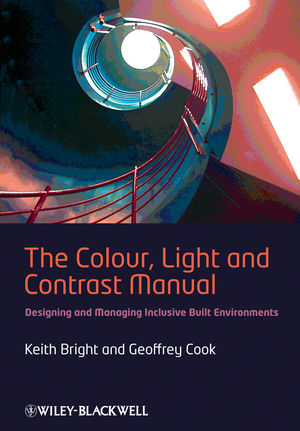
The Colour, Light and Contrast Manual
Wiley-Blackwell (an imprint of John Wiley & Sons Ltd) (Verlag)
978-1-4051-9504-1 (ISBN)
- Titel ist leider vergriffen;
keine Neuauflage - Artikel merken
Endorsed by the Society of Light and Lighting, this practical book offers comprehensive guidance on how colour, light and contrast can be incorporated within buildings to enhance their usability. The book provides state-of-the-art, clear guidance as well as a valuable information source for busy professionals involved in the design or management of new and existing environments. The ways colour, light and contrast are used within built environments are critical in determining how people interact with the space, and how confident, safe, and secure they will feel when doing so. They also have a major influence on a person's sense of well-being and their ability to use the environment independently and without undue effort. Understanding how to use colour and contrast and how they are influenced by both natural and artificial lighting is vital for all those involved in the design and management of the environments and spaces we all use. In recent years there has been a considerable amount of work undertaken to further our understanding of how colour, light and contrast affect emotion and sensory abilities, and how they can assist or hinder people in their everyday lives.
Other publications consider these issues individually but The Colour, Light and Contrast Manual: designing and managing inclusive built environments draws knowledge and information together to produce a unique, comprehensive and informative guide to how the three elements can work together to improve the design and management of environments for us all. Supporting website at: www.wiley.com/go/brightandcook
Keith Bright is Director of Keith Bright Consultants, anindependent access consultancy. Geoff Cook is a Reader in The School of Construction Managementand Engineering at the University of Reading; runs the MSc inInclusive Environments - Design and Management
About the authors. Foreword by Helen Taylor, Chair of the RIBA Inclusive DesignCommittee. Acknowledgements. Introduction. Chapter 1 Colour, lighting and contrast in inclusivedesign. Inclusive design. The principles of inclusive design. The benefi ts of adopting an inclusive design approach. Inclusive design, legislation, regulations and BritishStandards. Legislation. Regulations. British Standards. Other guidance and regulations for specific environments. The role of lighting in the creation of an inclusive, accessibleenvironment. The role of colour in the creation of an inclusive, accessibleenvironment. Chapter 2 Vision, hearing, colour and light. How people see colour and light. Processing information. Visual ability. The extent of blindness and partial sight. Classifying visual ability. Assessing visual acuity. Assessing fi eld of vision. Identifying functional visual ability. Vision and visual fi eld loss. No visual fi eld loss. Central vision fi eld loss. Peripheral vision fi eld loss. General vision fi eld loss. Illustrating the effects. Hearing ability. Colour, lighting and hearing. Colour, lighting and communicating. Chapter 3 Using lighting in an inclusive, accessibleenvironment. Light. Light source natural or daylight. Light source artifi cial light. Incandescent lamps. Discharge lamps. Metal-halide lamps. Sodium lamps. Light-emitting diodes. Luminaires. Task lights. Comfort. Glare. Health and safety. Healthy lighting. Safety. Lighting for an emergency. Generally. Types of emergency lighting. Stand-by lighting. Escape-route lighting. Low-level way-guidance systems. Emergency signage. Lighting controls. Exterior lighting. Traffi c routes. Light pollution. Enhancing usability. Enhancing safety. Confi dence and security. Lighting provision. Designing lighting for an inclusive, accessible environment. General lighting. Artifi cial lighting. Natural or daylighting. Task lighting. Emergency lighting. Lighting controls. Exterior lighting. Chapter 4 Colour and visual contrast in an inclusive,accessible environment. Colour and health. Colour and mood. Colour blindness. Colour in the built environment. Colour notation. The Commission internationale de l eclairage (CIE)colour measurement systems. Natural Colour System. Colour Palette System. The Munsell Colour System. RAL system. Contrast. Light Refl ectance Value. Measuring LRV. BS 8493:2008. Specifying 'reasonable' contrast. Gathering information. Using differences in LRV effectively in practice. Colour and contrast in the built environment: practical issuesfor larger surfaces. Walls and ceilings. Floor fi nishes. Skirtings. Doors. Colour and contrast in the built environment: practical issuesfor features. Nosings. Handrails. Lifts. Sanitary facilities. Sockets, switches and controls. Obstacles and potential hazards. Chapter 5 Case studies. Case Study 1 The Roundhouse, Camden. Case Study 2 The Arlington Arts Centre, Mary Hare,Newbury. Case Study 3 The Carrington Building, The University ofReading. Chapter 6 Resume of six relevant research projectson colour, lighting and contrast. Project 1 Using colour and contrast to improve the builtenvironment for visually impaired people (Project Rainbow). Background. Purpose. Project. Outcome. Project 2 Deafness, design and communication in the builtenvironment (Project Crystal). Background. Project. Outcome. Project 3 Emergency lighting and way-finding systems forvisually impaired people in smoke-free and smoke-filledenvironments. Phase One. Background. Project. Outcome. Phase Two. Background. Project. Outcome. Project 4 Colour and lighting design for intermodal transportenvironments. Background. Project. Outcome. Project 5 Legibility and conspicuity of emergency escape-routesignage (EERS) for normally sighted and visually impairedpeople. Background. Project. Outcome. Project 6 Lighting in the homes of blind or partially sightedpeople. Background. Project. Outcome. References. Glossary of terms. Index.
| Erscheint lt. Verlag | 16.3.2010 |
|---|---|
| Verlagsort | Chicester |
| Sprache | englisch |
| Maße | 169 x 239 mm |
| Gewicht | 582 g |
| Themenwelt | Technik ► Architektur |
| ISBN-10 | 1-4051-9504-5 / 1405195045 |
| ISBN-13 | 978-1-4051-9504-1 / 9781405195041 |
| Zustand | Neuware |
| Haben Sie eine Frage zum Produkt? |
aus dem Bereich


